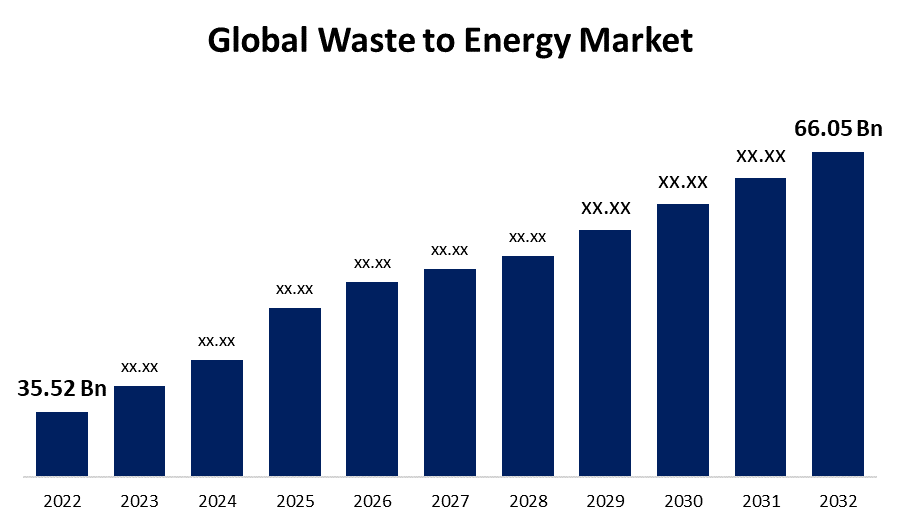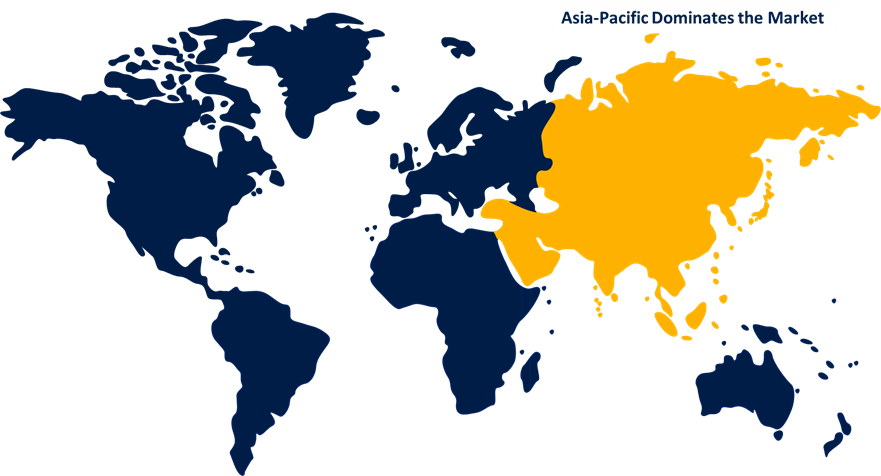Global Waste to Energy Market Size, Share, and COVID-19 Impact Analysis, By Technology (Thermochemical and Biochemical), By Waste Type (Municipal Solid Waste, Process Waste, Agriculture Waste, and Others), By Application (Electricity and Heat), By Region (North America, Europe, Asia-Pacific, Latin America, Middle East, and Africa), Analysis and Forecast (2022 – 2032).
Industry: Energy & PowerGlobal Waste to Energy Market Insights Forecasts to 2032
- The Global Waste to Energy Market Size was valued at USD 35.52 Billion in 2022.
- The Market is Growing at a CAGR of 6.4% from 2022 to 2032
- The Worldwide Waste to Energy Market Size is expected to reach USD 66.05 Billion by 2032
- Europe is expected to have significant growth during the forecast period

Get more details on this report -
The Global Waste to Energy Market Size is expected to reach USD 66.05 Billion by 2032, at a CAGR of 6.4% during the forecast period 2022 to 2032.
Market Overview
Waste-to-Energy is a process that converts solid waste materials into usable energy, typically in the form of electricity, heat, or fuel. It offers a sustainable solution for waste management while generating valuable resources. The process involves the combustion or thermal treatment of waste in specialized facilities called waste incinerators or biomass power plants. During the incineration process, heat is produced, which is then used to generate steam and drive turbines to produce electricity. This not only reduces the volume of waste but also minimizes greenhouse gas emissions and reliance on fossil fuels. WtE technologies have evolved to ensure efficient energy recovery and strict emission control measures. Additionally, the residual ash from the process can be safely disposed of, contributing to a more circular economy.
Report Coverage
This research report categorizes the market for waste to energy market based on various segments and regions and forecasts revenue growth and analyzes trends in each submarket. The report analyses the key growth drivers, opportunities, and challenges influencing the waste to energy market. Recent market developments and competitive strategies such as expansion, product launch, and development, partnership, merger, and acquisition have been included to draw the competitive landscape in the market. The report strategically identifies and profiles the key market players and analyses their core competencies in each sub-segments of the waste to energy market.
Global Waste to Energy Market Report Coverage
| Report Coverage | Details |
|---|---|
| Base Year: | 2022 |
| Market Size in 2022: | USD 35.52 Billion |
| Forecast Period: | 2022-2032 |
| Forecast Period CAGR 2022-2032 : | 6.4% |
| 2032 Value Projection: | USD 66.05 Billion |
| Historical Data for: | 2018-2021 |
| No. of Pages: | 200 |
| Tables, Charts & Figures: | 120 |
| Segments covered: | By Technology, By Waste Type, By Application, By Region. |
| Companies covered:: | Hitachi Zosen Inova AG, Suez, Covanta, Covanta Holding Corporation, China Everbright International Limited, Veolia, Abu Dhabi National Energy Company PJSC, Ramboll Group A/S, Babcock & Wilcox Enterprises, Inc., Attero, Viridor, Wheelabrator Technologies Inc., Xcel Energy Inc. |
| Pitfalls & Challenges: | COVID-19 Empact, Challenge, Future, Growth, & Analysis |
Get more details on this report -
Driving Factors
The Waste-to-Energy (WtE) market is driven by several factors, such as the growing global waste generation due to urbanization and population growth creates a need for effective waste management solutions. Additionally, increasing environmental concerns and the need to reduce greenhouse gas emissions drive the adoption of WtE as a sustainable alternative to landfilling. The rising demand for renewable energy sources further fuels the market, as WtE facilities can generate electricity and heat from waste. Government regulations and policies promoting waste management and renewable energy also play a crucial role in driving the market. Moreover, advancements in WtE technologies, such as improved efficiency and stricter emission control, enhance the market's attractiveness. Overall, the convergence of waste management, energy production, and environmental sustainability drive the growth of the waste-to-energy market.
Restraining Factors
The Waste-to-Energy market faces certain restraints, because of high capital costs associated with building and operating WtE facilities can hinder market growth. The complex nature of waste composition and varying regulations pose challenges in efficiently converting different types of waste into energy. Concerns regarding air emissions and the potential release of harmful pollutants from the incineration process create public opposition and regulatory hurdles. Additionally, the availability of alternative waste management methods, such as recycling and composting, can limit the demand for WtE solutions. Striking a balance between environmental sustainability, public acceptance, and economic viability remains a challenge for the waste-to-energy market.
Market Segmentation
- In 2022, the biochemical segment accounted for around 82.5% market share
On the basis of the technology, the global waste to energy market is segmented into thermochemical and biochemical. The biochemical segment dominates the Waste-to-Energy (WtE) market for several reasons, such as biochemical processes involve the conversion of organic waste into biofuels, biogas, and other valuable products through anaerobic digestion or fermentation. This segment holds a significant market share due to the increasing focus on sustainable and renewable energy sources. Biochemical WtE technologies offer numerous benefits, including reduced greenhouse gas emissions, efficient waste management, and the production of clean energy. Additionally, the versatility of organic waste as a feedstock makes it readily available and cost-effective for the biochemical segment. Moreover, government incentives and supportive policies promoting the use of biofuels and biogas further drive the dominance of the biochemical segment in the Waste-to-Energy market. The potential for resource recovery and the environmental advantages of bio-based energy solutions contribute to the growing market share of the biochemical segment.
- In 2022, the municipal solid waste segment dominated with more than 35.6% market share
Based on the type of waste, the global waste to energy market is segmented into municipal solid waste, process waste, agriculture waste, and others. The municipal solid waste (MSW) segment dominates the Waste-to-Energy (WtE) market for several reasons. Municipal solid waste, which consists of household, commercial, and institutional waste, represents a significant portion of the overall waste generated. This segment's dominance is driven by the growing need for effective waste management solutions for urban areas. MSW WtE facilities offer an environmentally sustainable approach to handle large volumes of waste while generating energy. Additionally, governments and municipalities worldwide are focusing on reducing landfilling and promoting circular economy practices, further driving the demand for MSW WtE solutions. The scalability and compatibility of MSW with various WtE technologies make it a preferred feedstock. Furthermore, the energy potential and resource recovery capabilities of MSW contribute to the dominance of the municipal solid waste segment in the waste-to-energy market.
Regional Segment Analysis of the Waste To Energy Market
- North America (U.S., Canada, Mexico)
- Europe (Germany, France, U.K., Italy, Spain, Rest of Europe)
- Asia-Pacific (China, Japan, India, Rest of APAC)
- South America (Brazil and the Rest of South America)
- The Middle East and Africa (UAE, South Africa, Rest of MEA)
Asia-Pacific dominated the market with more than 46.5% revenue share in 2022.

Get more details on this report -
Based on region, the Asia-Pacific region dominates the Waste-to-Energy (WtE) market for several reasons, due to rapid industrialization, urbanization, and population growth in countries like China, India, and Japan have led to significant increases in waste generation. This necessitates effective waste management solutions, driving the demand for WtE facilities. Additionally, the region is experiencing a growing energy demand, and WtE provides a dual benefit of waste management and energy production. Government initiatives and policies promoting renewable energy and sustainable waste management practices further contribute to the dominance of Asia-Pacific in the market. Furthermore, advancements in WtE technologies, such as efficient incineration processes and emission control measures, have made WtE solutions more attractive in the region. Overall, the combination of waste management needs, energy demand, supportive policies, and technological advancements positions Asia-Pacific as a dominant player in the waste to energy market.
Recent Developments
In June 2022, AVR chose to collaborate with the Swedish business HaloSep AB to investigate the feasibility of locally handling its hazardous flue gas cleaning leftovers. The HaloSep operation is a unique approach for converting hazardous trash into safe and useful products. By using HaloSep's solution, AVR in Rotterdam would become more circular by recovering material resources and lowering the plant's environmental footprint.
In April 2022, Veolia announced the launch of two new initiatives aimed at generating local, sustainable, and low-carbon energy sources. The firm is establishing the world's largest bio refinery project in Finland, which will produce CO2-neutral bio-methanol from the pulp production process. Second, the Group is collaborating with Waga Energy to commission France's largest biomethane production plant, which will recover biogas from a non-hazardous landfill.
Competitive Analysis:
The report offers the appropriate analysis of the key organizations/companies involved within the global waste to energy market along with a comparative evaluation primarily based on their product offering, business overviews, geographic presence, enterprise strategies, segment market share, and SWOT analysis. The report also provides an elaborative analysis focusing on the current news and developments of the companies, which includes product development, innovations, joint ventures, partnerships, mergers & acquisitions, strategic alliances, and others. This allows for the evaluation of the overall competition within the market.
List of Companies:
- Hitachi Zosen Inova AG
- Suez
- Covanta
- Covanta Holding Corporation
- China Everbright International Limited
- Veolia
- Abu Dhabi National Energy Company PJSC
- Ramboll Group A/S
- Babcock & Wilcox Enterprises, Inc.
- Attero
- Viridor
- Wheelabrator Technologies Inc.
- Xcel Energy Inc.
Key Target Audience
- Market Players
- Investors
- End-Users
- Government Authorities
- Consulting and Research Firm
- Venture Capitalists
- Value-Added Resellers (VARs)
Market Segment
This study forecasts revenue at global, regional, and country levels from 2019 to 2032. Spherical Insights has segmented the global waste to energy market based on the below-mentioned segments:
Waste To Energy Market, By Technology
- Thermochemical
- Biochemical
Waste To Energy Market, By Waste Type
- Municipal Solid Waste
- Process Waste
- Agriculture Waste
- Others
Waste To Energy Market, By Application
- Electricity
- Heat
Waste To Energy Market, Regional Analysis
- North America
- US
- Canada
- Mexico
- Europe
- Germany
- UK
- France
- Italy
- Spain
- Russia
- Rest of Europe
- Asia Pacific
- China
- Japan
- India
- South Korea
- Australia
- Rest of Asia Pacific
- South America
- Brazil
- Argentina
- Rest of South America
- Middle East & Africa
- UAE
- Saudi Arabia
- Qatar
- South Africa
- Rest of Middle East & Africa
Need help to buy this report?